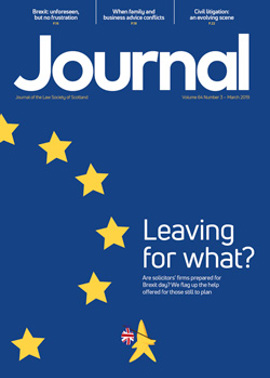At the boundary's edge

Tim Marshall’s bestseller, Prisoners of Geography, looks at how countries’ foreign policy is shaped profoundly by their physical landscape. Mountains protect against invasion. Rivers assist trade, but also divide peoples. Great plains allow for industrial-scale agriculture, but provide an open door for hostile armies. Russia’s hostility to the alignment with the West of its former satellites Latvia, Lithuania and Estonia is unwelcome, but more comprehensible when we understand that between 1812 and 1941, Russia fought an invading foe every 33 years. Technology has overcome many geographical barriers: drone warfare in the mountains of Afghanistan is fought with devastating results from a screen in Nevada. But a country’s physical features are still fundamental.
Business, including legal practice, is war without guns. There was a time when a firm’s reach was defined strictly by geography. Lawyers thought of themselves as confined to their jurisdiction. Many were happy to define themselves as serving their local area. Any suggestion they might practise beyond it was greeted as if a proposal that they open on Mars.
Over time, a more expansive approach developed, and now national and international firms proliferate. Today, most of Scotland’s largest firms either have a physical presence in London, or have been merged with top-tier English firms. Those that still have offices only in Scotland invest large sums in building English and international referral networks. Small and medium-sized firms look at these behemoths and conclude they have nothing in common. They could not be more wrong. Most of them grew from small beginnings. A firm’s destiny is limited less by its locality, than the boundaries of its imagination.
We now have tools our forebears never had. The internet has transformed the ability of every size of business to reach a global marketplace. A good example of harnessing this potential is the accountancy firm Armstrong Watson. It has built a UK-wide reputation as advisers to law firms. While it now has physical offices in several locations, it has done it from a base not in London or a major city, but Carlisle.
Closer to home, in the late 90s and early 2000s, my firm, which began as a sole practice, was serving clients across the UK from two offices, one in Glasgow and one in Manchester.
Where clients shop
Do clients care these days whether their providers are local or not? The internet has changed their attitude profoundly. Conveyancing is an excellent example. It used to be the archetypal local service, and throughout the UK there are still many excellent local firms. But they face formidable competition from a network of “big sheds”: volume providers serving clients often hundreds of miles away, who find them perfectly satisfactory. Not all of them are law firms.
It is a similar story with debt recovery, personal injury, remortgaging and executry, to name just a few. Every day, corporate and commercial transactions are successfully completed without client and adviser ever having been in the same room. There are some services, family law for example, where clients may prefer to meet their lawyer face-to-face, and older people especially (though by no means all) are less comfortable with distance. But there is virtually no service now which cannot be offered remotely.
Your own territory?
What does it take for a firm to expand successfully beyond its location?
First, be clear about what markets you want to target, and what it is about your offering that will make it stand out.
Secondly, invest in top quality communications. In general, clients will be less concerned about physical remoteness if they are confident that in all other ways their lawyer is close. Making contact and getting prompt, empathetic advice must be seamless. This means not only excellent systems, but training, and a sincere commitment to fantastic personal service.
Thirdly, the internet is a wonderful tool, but like all tools, needs skilful handling. Be thoughtful and imaginative in building the firm’s online presence, and its people’s visibility. You will probably need expert help, and you will also need a realistic budget, but taking it step by step, the cost need not be prohibitive.
Is there a future for local practice? I passionately believe there is, but it is becoming more difficult. Just as a drone operated from Nevada can vaporise a jihadi in Helmand, the imminent introduction of alternative business structures (ABS), the advance of technology, the resources of national competitors, and clients placing far more value on price, service and brand recognition than proximity, mean that invasion will become much harder to repel. It’s a threat that is better met not by retreating to a bunker, but raising one’s eyes to the horizon.
In this issue
- How will Brexit affect my mother-in-law?
- Settling the debate on sequestration
- Taking wellbeing seriously
- How will personal data continue to flow after Brexit?
- Buildmark, and a little extra help for NHBC
- Reading for pleasure
- Opinion: Laurie Anderson
- Book reviews
- Profile: Lord Mackay of Clashfern
- President's column
- People on the move
- Is your legal software ready to remain compliant in 2019?
- What's the deal?
- Ready to leave?
- A tapering opportunity
- Brexit: no dealbreaker either
- The business of divorce
- Trailblazing 12
- Cohabitants: rebalancing the law
- Litigation: an evolving scene
- Chain transactions
- When delay is not fatal
- Data protection – deal or no-deal?
- Two cases and an order
- Reshaping trade mark law
- When the wheels come off
- Parentage or privacy?
- Access right, right of access or right of way?
- Team of one
- Public policy highlights
- OPG update
- Housing specialism added to accreditation list
- At the boundary's edge
- Keep the dual role
- Executry and trust accounting: new guidance
- Moving nightmares
- Accredited paralegal update
- Sign up for conference
- Accredited Paralegal Committee profile
- Ask Ash






